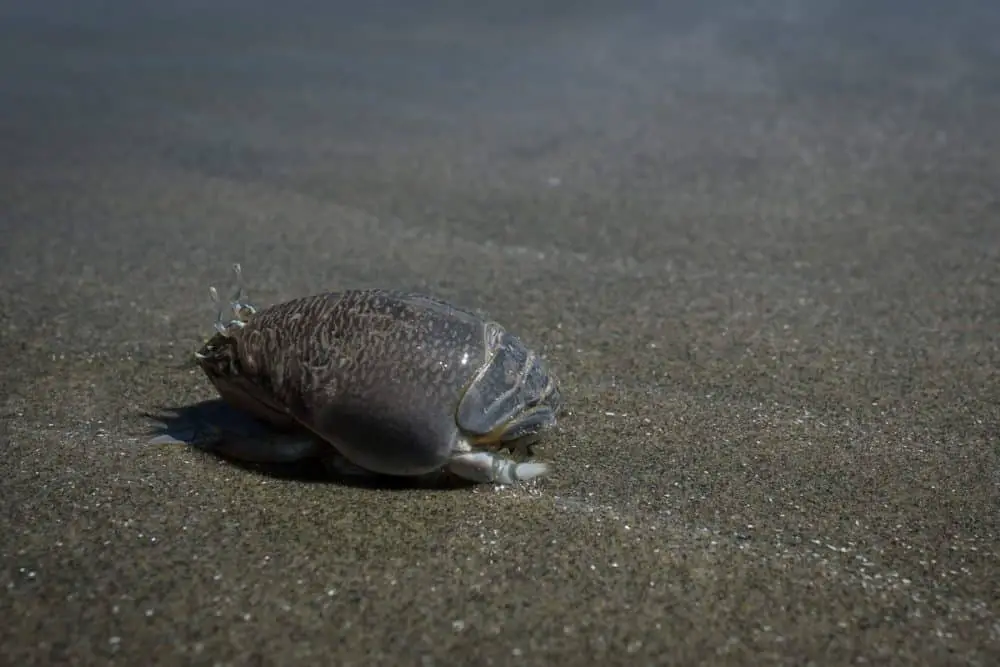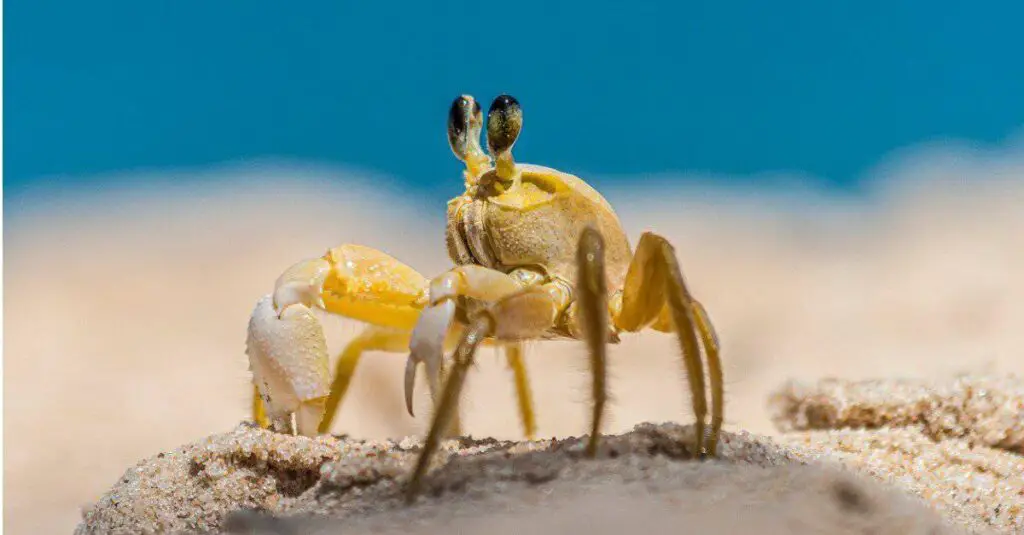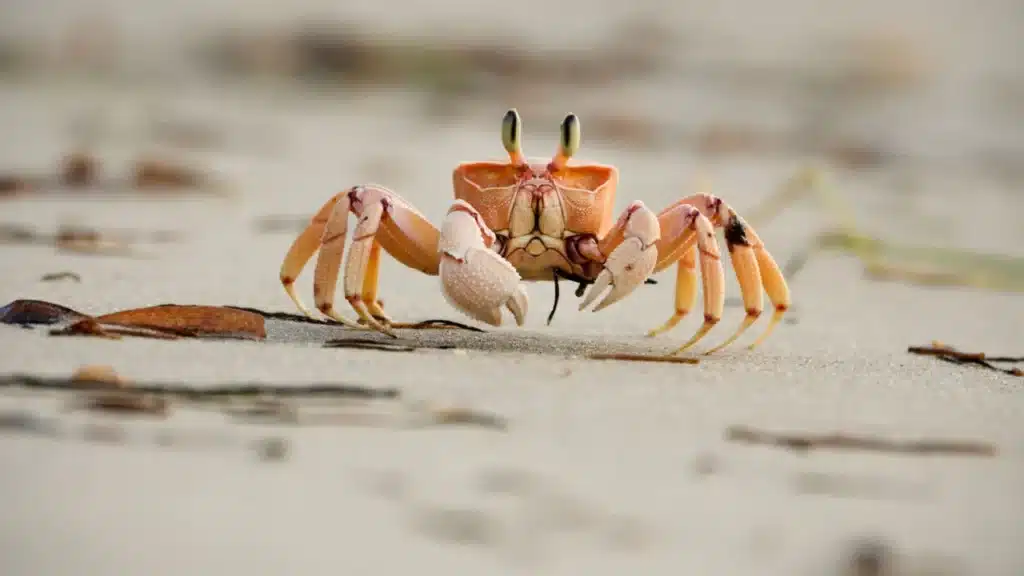What Do Sand Crabs Eat

Introduction
What Do Sand Crabs Eat: Sand crabs, often found scuttling along sandy shorelines, are intriguing creatures with a unique diet that plays a vital role in coastal ecosystems. These small, burrowing crustaceans have adapted to marine life in the intertidal zone, where the land meets the sea. While they might appear inconspicuous, their feeding habits are of paramount importance to both their own survival and the broader ecological balance of coastal regions.
Sand crabs, also known as mole crabs or sand fleas, subsist primarily on a diet consisting of tiny organisms and detritus found within the sandy substrate. Their diet typically includes planktonic organisms, small algae, microorganisms, and bits of decaying plant and animal matter. They use their specialized appendages to filter and capture these microscopic food sources from the receding waves as they wash over the sandy beach.
Understanding the dietary preferences of sand crabs is essential not only for comprehending their ecological significance but also for appreciating their role in nutrient cycling along the shoreline. By consuming detritus and microorganisms, these crabs help break down organic matter, releasing nutrients back into the ecosystem. This, in turn, influences the health of the surrounding flora and fauna, creating a delicate web of interactions that sustains coastal life.
In this exploration of what sand crabs eat, we delve deeper into their diet, shedding light on the ecological implications of their feeding habits and the intricate balance they maintain in coastal ecosystems.

What do I feed my sand crab?
Sand crabs eat algae, plankton, mollusks, and other decaying animals. A sand crab eats microscopic plankton, mollusks, other smaller crabs, algae, and more. They are known as scavengers, and don’t often eat anything that isn’t easily accessible to them hiding in their sandy homes.
Feeding your sand crab in captivity requires replicating its natural diet as closely as possible. Since these tiny crustaceans primarily feed on tiny organisms and detritus found in sandy beach substrates, it’s essential to provide them with a suitable diet.
A diet for captive sand crabs typically includes a mix of small, live or frozen foods. This can consist of microalgae, plankton, small crustaceans, and even bits of decaying plant matter. You can source live or frozen foods from reputable aquarium supply stores or online suppliers.
It’s important to offer a variety of food options to ensure your sand crab gets a well-rounded diet. Small portions of finely chopped seafood, like shrimp or fish, can also be provided. However, avoid overfeeding, as this can lead to water quality issues in the enclosure.
Remember to maintain a clean environment for your sand crab by regularly removing any uneaten food and debris to prevent water contamination. Also, ensure that your crab has access to clean, dechlorinated seawater or marine aquarium water.
By mimicking the natural diet of sand crabs and maintaining proper care conditions, you can keep your captive sand crab healthy and thriving.
Can sand crab bite?
In addition, sand crabs, unlike most other varieties of crabs, do not bite or pinch, making them completely harmless. Just be sure to leave you sand crabs right where you found them on the beach. Sand crabs cannot be transferred to aquariums as pets, and are dependent on the ocean environment to survive.
Sand crabs, also known as mole crabs or sand fleas, are not known for having a bite that poses any danger to humans. Their tiny pincers, located near the front of their bodies, are designed primarily for sifting through sand in search of food and burrowing into the substrate for protection.
In most cases, when a human encounters a sand crab, it’s not the crab’s pincers that pose any threat. Instead, it’s more common for the crab to use its pincers for defense by pinching if it feels threatened or handled roughly. However, their pinches are usually very gentle and rarely result in any pain or injury to humans.
It’s important to handle these small creatures with care and respect when observing them in their natural habitat. If you choose to pick up a sand crab, do so gently and avoid squeezing or mishandling them. Additionally, it’s advisable to wash your hands thoroughly after handling any wildlife to maintain good hygiene and to avoid transferring any potential contaminants from the environment.
While sand crabs can use their pincers defensively, they are not typically considered to be capable of inflicting painful bites or causing harm to humans.
Are sand crabs friendly?
Sand crabs are completely harmless to people and even entertaining to observe as they move around with the tide. This article will cover some important facts about this animal’s identification, habitat, and diet, including how to catch them and how to cook them.
Sand crabs, by nature, are not social creatures, and they don’t exhibit what humans might consider friendliness. Their behavior is primarily driven by survival instincts and basic needs. Sand crabs spend much of their lives burrowed in the sand, emerging only briefly to feed and reproduce.
When encountered by humans on the beach, sand crabs typically exhibit evasive behavior, burrowing quickly into the sand to escape perceived threats. This behavior is more about self-preservation than any form of friendliness. In fact, their natural instinct is to avoid interactions with potential predators, including humans.
It’s important to remember that sand crabs are wild animals and should be observed respectfully in their natural habitat. Attempting to handle or disturb them can cause undue stress and harm to these delicate creatures. Maintaining a respectful distance and minimizing disruptions is the best way to coexist with sand crabs while enjoying the beach environment.
While sand crabs may not be “friendly” in the way we typically think of it, they play a vital role in their ecosystem and should be appreciated and respected for their contribution to coastal environments.
What do crabs eat?
Crabs eat an omnivorous diet. Smaller crabs eat algae, seaweed, worms, small clams, and shrimp. Larger crabs can eat squid, snails, mussels, other crabs and small fish. Some species of crabs can eat hard foods like barnacles, starfish and even sand dollars.
Crabs are opportunistic omnivores, which means they have a diverse diet and will eat a wide range of food depending on what’s available and their species. Their feeding habits vary from species to species, but here’s a general overview of what crabs eat:
- Plant Material: Many crab species consume algae, seagrasses, and other plant matter. They use their specialized mouthparts to scrape, cut, and shred plant material.
- Detritus: Crabs are crucial in breaking down organic matter, such as dead plants and animals, into smaller particles known as detritus. This recycling of nutrients is essential for coastal ecosystems.
- Small Animals: Crabs are opportunistic predators and scavengers. They may prey on small animals like mollusks, small fish, plankton, and even other crabs if they get the chance.
- Filter-Feeding: Some crabs are filter feeders, using their feathery appendages to capture tiny particles, such as plankton, suspended in the water.
- Scavenging: Many crabs are scavengers, feeding on decaying organisms and organic debris they find on the seafloor or shoreline.
- Carnivorous Habits: Larger crab species, like the coconut crab, can be more carnivorous, occasionally eating birds, rodents, and carrion.
Crabs’ diets can vary depending on their habitat, size, and available food sources. Their adaptability and diverse feeding habits contribute to their success in a wide range of ecosystems, from the deep sea to intertidal zones.
Do sand crabs need oxygen?
Crabs breathe through gills. For gills to work, they must be able to take in oxygen and transport it into the animal’s bloodstream. The gills of crabs are located under the carapace near the first pair of walking legs. The oxygen that crabs need is taken into the gills either through water or moisture in the air.
Sand crabs, also known as beach crabs or mole crabs, are fascinating creatures that inhabit sandy beaches along coastlines worldwide. One common question about these small, burrowing crustaceans is whether they need oxygen to survive.
The answer is yes, sand crabs do require oxygen to live. While they are well adapted to their sandy environments, they are not fully aquatic and cannot breathe underwater like fish or some other marine creatures. Instead, sand crabs utilize a specialized adaptation that allows them to extract oxygen from the air.
Sand crabs have gill-like structures called “branchiostegites” located on the underside of their bodies, near their legs. These branchiostegites function like tiny lungs, extracting oxygen from the air when the crabs come to the surface of the sand. Sand crabs are often seen burrowing in the wet sand at the water’s edge, where they can easily access both water and air. They use their feather-like appendages, called pleopods, to fan water over their branchiostegites and extract oxygen.
Sand crabs are well adapted to their sandy beach habitats, but they still rely on oxygen from the air to survive, using specialized structures to extract the essential gas while living in the intertidal zone.
How do sand crabs feed?
Sand crabs, scientifically known as Emerita analoga, are fascinating crustaceans found along sandy shores of various coastal regions. Their feeding habits are intricately tied to their unique anatomical features and behavior. These creatures are filter feeders, meaning they primarily consume small organic particles suspended in the water.
To feed, sand crabs employ specialized appendages called maxillipeds, located near their mouthparts. These maxillipeds are equipped with fine, hair-like structures known as setae. They extend these appendages into the surf zone, where waves wash over the beach. As water flows through the setae, they trap microscopic plankton, detritus, and other organic matter, which then adhere to a mucous layer on the maxillipeds.
Once the setae are laden with food particles, the sand crab brings its maxillipeds close to its mouth and combs them with specialized comb-like structures. This process, known as grooming, allows the crab to extract the captured food from the setae and direct it towards its mouth for consumption.
This method of feeding is not only efficient but also crucial for the sand crab’s survival. It ensures that they make the most of the constantly shifting and nutrient-rich environment of the intertidal zone, where they play a vital role in the ecosystem’s nutrient cycling and overall health.
Do sand crabs ever eat larger prey?
Sand crabs, also known as Emerita analoga, primarily feed on small organic particles suspended in the water, making them filter feeders. Their feeding habits are finely tuned to capturing plankton, detritus, and other microscopic organisms. While they are highly efficient at this, they are not known to consume larger prey.
The anatomy of sand crabs is adapted for their filter-feeding lifestyle. Their specialized maxillipeds, equipped with setae, are designed to trap tiny particles as water passes through them. This method is optimized for capturing the small-scale organisms that populate the intertidal zone.
Unlike predatory crustaceans, such as some species of crabs and lobsters, sand crabs do not possess the powerful claws or appendages necessary to catch and manipulate larger prey. Their diet is primarily composed of the abundant microorganisms that are present in their sandy habitat.
While sand crabs play a vital role in coastal ecosystems by recycling nutrients and supporting food webs, their feeding behavior is focused on the microscopic, ensuring that they are well-adapted to thrive in their specific ecological niche. This specialization helps maintain the delicate balance of life in the intertidal zone, contributing to the overall health and biodiversity of coastal environments.
Are sand crabs a food source for other animals?
Sand crabs serve as a significant food source for various coastal predators, playing a crucial role in the intertidal food web. Birds, fish, and even some larger crustaceans consider them a staple part of their diet.
Many shorebirds, such as seagulls, sandpipers, and plovers, rely heavily on sand crabs as a source of sustenance. These birds have adapted their feeding behavior to exploit the abundance of these small crustaceans along the shoreline. They use their keen senses and specialized bills to probe the sand, extracting sand crabs from their burrows.
Fish, particularly those found in coastal waters, also include sand crabs in their diet. Species like surfperch, croakers, and flounders are known to feed on them. They play a vital role in the diets of these fish, providing them with essential nutrients and energy.
In addition to birds and fish, various species of larger crustaceans, like crabs and certain types of lobsters, also prey on sand crabs. These predators possess the necessary appendages and strength to effectively capture and consume them.
Sand crabs play a critical ecological role as a foundational species in coastal ecosystems, connecting the lower levels of the food chain to higher trophic levels and contributing to the overall health and balance of these dynamic environments.

Conclusion
The dietary habits of sand crabs are not only a fascinating aspect of their biology but also a critical component of coastal ecosystems. These unassuming crustaceans play a pivotal role in nutrient cycling along sandy shorelines, where they feed on tiny organisms and detritus hidden within the beach’s sandy substrate.
By filtering plankton, algae, microorganisms, and decomposing matter from the receding waves, sand crabs help recycle nutrients, enriching the coastal environment. Their feeding activities contribute to the overall health and productivity of the ecosystem, ultimately benefiting the various species that inhabit these dynamic coastal zones.
Moreover, sand crabs serve as a crucial food source for shorebirds, fish, and other predators, further illustrating their significance in the food web. Their presence and diet have ripple effects throughout the ecosystem, influencing the distribution and abundance of other species.
Understanding what sand crabs eat is not just a matter of scientific curiosity but also a key to preserving the delicate balance of coastal environments. As these habitats face increasing threats from human activities and climate change, comprehending the role of sand crabs in these marine ecosystems becomes even more critical for conservation efforts.
Sand crabs, through their humble diet, demonstrate the intricate connections that exist within nature. Their story underscores the importance of preserving these coastal habitats and the myriad of species, both large and small, that call them home.



